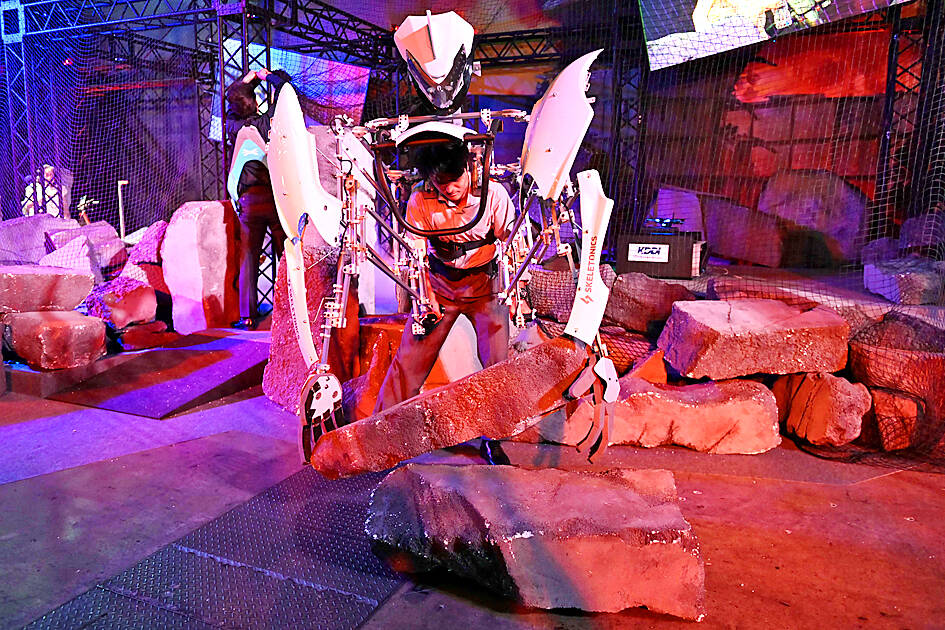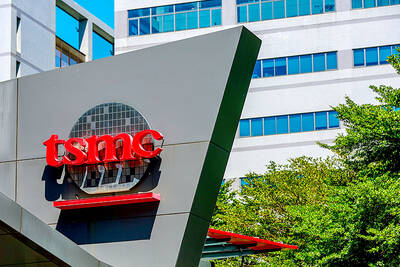With a drone camera, a survivor is spotted in the rubble. A robot on tracks brings him water while rescuers in exoskeletons clear an escape route for an autonomous stretcher to take her to safety.
This is the futuristic vision on display at the Japan Mobility Show, aiming to exhibit how technology can help and sometimes replace humans in a country short of workers and no stranger to disasters.
However, so as not to alarm people, the imaginary tragedy is caused by Godzilla, who has unleashed catastrophe in Japanese disaster films since the 1950s. In Japan nearly 30 percent of the country’s population is 65 or older.

Photo: AFP
“Because of the decline of the population there are fewer and fewer people available for dangerous tasks,” said Tomoyuki Izu, founder of Attrac Lab, a local start-up specializing in autonomous mobility.
“My idea is to help people such as firefighters with my machines,” Izu, 61, said.
It was Attrac Lab that codeveloped the small delivery robot squeezing through the cardboard rubble at the Japan Mobility Show and designed the remote-control stretcher on wheels or tracks.
For now the Japanese government favors “traditional equipment” for relief efforts, he said at the event, which opened to the public yesterday.
However, Izu believes there will eventually be a market for more advanced technology.
“There’s a lots of anime with humanoid robots in Japan, and therefore people love them, but these kinds of autonomous vehicles are still very strange for them,” he said.
Since 2016, Japan’s Kawasaki Heavy Industries Ltd (KHI) has been developing Kaleido, a robust humanoid robot capable of delicately lifting and moving injured people.
“In the future, this robot will be able to save people, or go to dangerous zones, like fires,” said Itsuki Goda from the robotics division of KHI.
He conceded that the machine needs more development on its scanning capabilities to get through difficult terrain.
“We need more years of development if we want to use it in real situations, where conditions are always different,” he said.
Kaleido’s current load capacity of 60kg would be increased soon with a new prototype, Goda said.
Price is also an issue.
Right now this robot is “maybe 10 times more expensive than a human, but if we produce 10,000 of them per year, the price will go down rapidly,” Goda added.
Since the Fukushima Dai-ichi nuclear power plant disaster in 2011, another niche segment has exploded: robots to clear up disaster areas that are difficult or dangerous to access.
Engineering firm Sugino Machine Ltd presented a powerful, but small, robotic arm rigged on crawlers that can work in areas that emergency workers cannot go.
The machine was built in 2018 for a nationally run atomic research agency, as Japan continues the work to decommission the Fukushima Dai-ichi nuclear power plant.
“This can be used for initial damage assessment or to remove debris or to remove heavy items that people cannot lift,” said Akira Inujima from Sugino Machine.
Tools can be attached to its arm, such as image, temperature or radioactivity sensors, or a high-pressure water lance.
“We have a shortage of labor. It is difficult to go all robot, but we can offer solutions to help people’s work,” he said.
“After Fukushima, we have been able to continue technological development because there has been project after project [heavily supported by the government], like removing debris, that needs our work,” he said. “It’s important to continue this work and not make this fade away.”

The DBS Foundation yesterday announced the launch of two flagship programs, “Silver Motion” and “Happier Caregiver, Healthier Seniors,” in partnership with CCILU Ltd, Hondao Senior Citizens’ Welfare Foundation and the Garden of Hope Foundation to help Taiwan face the challenges of a rapidly aging population. The foundation said it would invest S$4.91 million (US$3.8 million) over three years to foster inclusion and resilience in an aging society. “Aging may bring challenges, but it also brings opportunities. With many Asian markets rapidly becoming super-aged, the DBS Foundation is working with a regional ecosystem of like-minded partners across the private, public and people sectors

BREAKTHROUGH TECH: Powertech expects its fan-out PLP system to become mainstream, saying it can offer three-times greater production throughput Chip packaging service provider Powertech Technology Inc (力成科技) plans to more than double its capital expenditures next year to more than NT$40 billion (US$1.31 billion) as demand for its new panel-level packaging (PLP) technology, primarily used in chips for artificial intelligence (AI) applications, has greatly exceeded what it can supply. A significant portion of the budget, about US$1 billion, would be earmarked for fan-out PLP technology, Powertech told investors yesterday. Its heavy investment in fan-out PLP technology over the past 10 years is expected to bear fruit in 2027 after the technology enters volume production, it said, adding that the tech would

Taiwan Semiconductor Manufacturing Co (TSMC, 台積電) has secured three construction permits for its plan to build a state-of-the-art A14 wafer fab in Taichung, and is likely to start construction soon, the Central Taiwan Science Park Bureau said yesterday. Speaking with CNA, Wang Chun-chieh (王俊傑), deputy director general of the science park bureau, said the world’s largest contract chipmaker has received three construction permits — one to build a fab to roll out sophisticated chips, another to build a central utility plant to provide water and electricity for the facility and the other to build three office buildings. With the three permits, TSMC

YEAR-END BOOST: The holiday shopping season in the US and Europe, combined with rising demand for AI applications, is expected to drive exports to a new high, the NDC said Taiwan’s business climate monitor improved last month, transitioning from steady growth for the first time in five months, as robust global demand for artificial intelligence (AI) products and new iPhone shipments boosted exports and corporate sales, the National Development Council (NDC) said yesterday. The council uses a five-color system to measure the nation’s economic state, with “green” indicating steady growth, “red” suggesting a boom and “blue” reflecting a recession. “Yellow-red” and “yellow-blue” suggest a transition to a stronger or weaker condition. The total score of the monitor’s composite index rose to 35 points from a revised 31 in August, ending a four-month